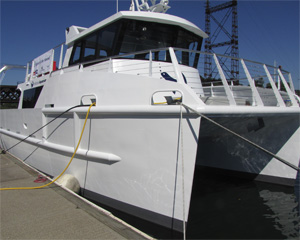The first hybrid-electric research vessel in the U.S. is ready to begin work in Long Island Sound.
R/V Spirit of the Sound was christened in September at the Maritime Aquarium of Norwalk, Conn. The 63-foot aluminum catamaran, equipped with a high-tech classroom and a science-ready aft working deck, was built at Robert E. Derecktor Inc. shipyard in Mamaroneck, N.Y.
The hybrid vessel is scheduled to begin seal-spotting cruises in December. The boat soon will be involved with scientific research in Long Island Sound. It will educate school students on oceanography, marine biology and maritime careers, and sail for marine study cruises and other public outings. Capacity is 65 people.
BAE Systems Inc. made the hybrid-electric propulsion system with Corvus Energy and Northern Lights Hybrid Marine. Aside from the emission-free battery power, Spirit of the Sound is equipped with environmentally friendly features including biodegradable insulation and solar panels, which feed emergency power.
Public cruises are usually about two hours long, and the aquarium asked for the capability to run on battery power for an entire trip at the boat’s normal operating speed of up to 12 knots, said project manager Robert Kunkel, president of Alternative Marine Technologies (Amtech).
“They told us that it had to be the absolute greenest vessel that it could be,” Kunkel said.
 |
|
Four of the 63-foot catamaran’s seven batteries. The battery compartment is located aft and has its own fixed firefighting system. The air in the compartment is changed every minute. |
|
Dom Yanchunas |
“We set the battery system up so it can run at full speed and trawling speed for two hours, and they can come back and charge the batteries,” he said. “So it can run a full day without any emissions.”
The hybrid system, which reduces fuel consumption by an estimated 75 percent, is very quiet. “You don’t hear a thing when she comes up the harbor,” Kunkel said. “The scientists like the fact that it is a quiet environment for them to take their data.”
The catamaran design is from Incat Crowther. The aft working deck includes an A-frame and dive platforms, and there are plans to install a winch.
Live images from the Furuno navigation electronics or VideoRay remotely operated vehicle can be projected for students to view on a flat-screen TV in the climate-controlled indoor floating classroom, which also has microscopes and Wi-Fi.
The vessel operates with five crew — captain, two deck hands and two educators. That means it can handle 60 guests.
The $2.7 million Spirit of the Sound was built entirely with private funds. It replaces the aquarium’s previous vessel, R/V Oceanic, a diesel-powered fiberglass trawler. The 40-foot Oceanic’s capacity was only 29 people. Whereas a busload of students boarded Oceanic in two shifts, Spirit of the Sound can take on an entire busload of kids for a single voyage.

